CRN's 2019 Products Of The Year
CRN editors looked at the best new products and major updates of 2019 and then turned to solution providers to choose the winners based on technology, revenue and profit opportunities, and customer demand.
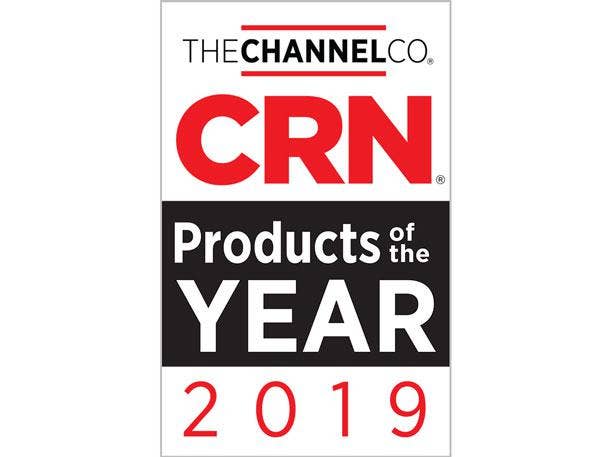
The Best Of The Best
CRN’s 2019 Products of the Year awards honor the best new products and major updates that made it onto our radar over the past year.
Our editors selected product finalists among 22 top technology categories for the IT channel, ranging from software and security to on-premises infrastructure and cloud. We then asked solution providers to determine winners based on how the products rate on technology, revenue and profit opportunities, and customer demand. The survey received more than 5,000 product ratings from solution providers. The product receiving the highest overall score in each category is named the winner in the category.
What follows are the winners and finalists in the 2019 CRN Products of the Year awards.
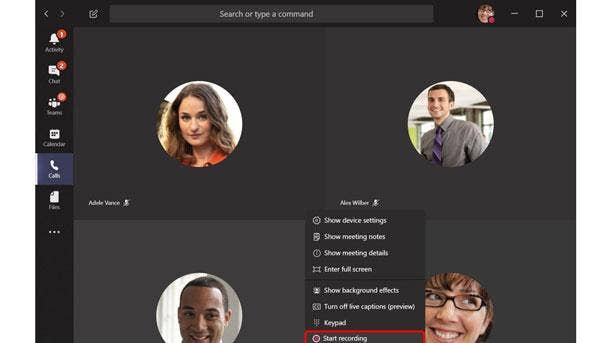
COLLABORATION
MICROSOFT TEAMS
WINNER: OVERALL
For its fast-growing Teams collaboration platform, Microsoft has continued to add new functionality at a rapid pace. Recently added features include announcements (for drawing attention to important news in a channel); channel cross-posting (for posting a message into multiple channels and different teams simultaneously); priority notifications (which alert recipients to messages that are time-sensitive); and the addition of moderators to manage posting in a channel. Other key updates have included live captions and meeting recording, along with automatic transcription and translation. Microsoft is also looking to better support partners in helping customers move to Teams, with the recent debut of a new partner-led Teams trial.
Subcategory Winner—Revenue and Profit: Cisco Webex Teams
Updates to the Cisco Webex Teams platform have included the addition of threading in chat so users can reply directly to a message regardless of when it was originally sent. Users can also now easily use Webex Teams to make calls using their phone number.
Finalist: 8x8 X Series
The 8x8 X Series cloud communications platform has seen major updates including the release of 8x8 Video Meetings, which lets users directly join meetings from their web browser without needing to download an application or plugin.
Finalist: Intermedia Unite
Recent enhancements to the Intermedia Unite UnifiedCommunications-as-a-Service platform include a new analytics platform, Intermedia Unite Envision. The offering tracks the performance of Intermedia UC and collaboration tools in real time—for instance, by monitoring voice and video call quality and identifying major issues.
Finalist: RingCentral Office
With the RingCentral Office platform, RingCentral pairs a cloud phone system with high-definition videoconferencing, audio conferencing and real-time messaging. Other key capabilities include file sharing, call forwarding, automatic call recording and advanced call analytics.
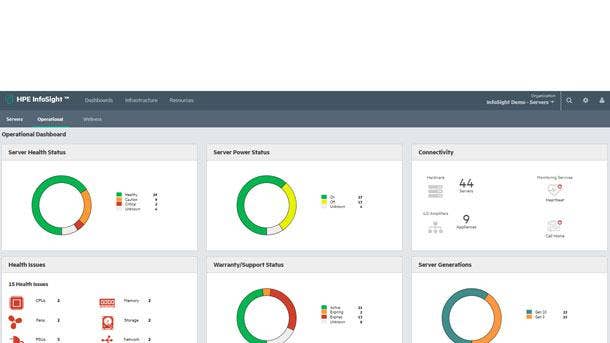
ENTERPRISE SOFTWARE
HPE INFOSIGHT
WINNER: OVERALL
Hewlett Packard Enterprise has been building out its InfoSight artificial intelligence management tool with new capabilities to help partners better manage their customers’ on-premises and cloud-based IT infrastructures. The new capabilities—including a workload planner and an intelligent multitenant recommendation engine, as well as further integration with HPE’s GreenLake consumption-based IT model—help partners to provide a wide range of new services to clients. With the enhanced InfoSight, partners can better understand customers’ existing environments as a way to initiate more intelligent sales conversations; provide breakfix services for their entire environment; sell platform refreshes and upgrades; focus infrastructure for specific workload requirements; and introduce valuable advisory services.
Finalist: AppDynamics
Cisco’s application performance monitoring software arm, AppDynamics, recently unveiled new features aimed at boosting visibility and insight for users. Those include Serverless Agent for AWS Lambda, which extends visibility to serverless functions, and AppDynamics for ACI, which brings together application intelligence from AppDynamics and Cisco’s software-defined networking offering, ACI.
Finalist: Microsoft Dynamics 365
Dynamics 365, Microsoft’s combination cloud CRM and ERP system, recently received partner-focused advancements including a new version of the Dynamics 365 Nonprofit Accelerator, featuring greater data transparency and streamlined implementation. Partners building financial services solutions also got a boost through new financial services integrations for Dynamics 365.
Finalist: Oracle Autonomous Database
Dedicated With the addition of Autonomous Database Dedicated, Oracle offers a private database cloud that is customizable and runs on dedicated Oracle Exadata infrastructure within the Oracle Cloud platform. The Autonomous Database Dedicated service enables users to run databases at any scale and delivers a high degree of workload isolation for enhanced security.
Finalist: Splunk Enterprise 7.2
Splunk Enterprise 7.2 has brought the ability to scale up to managing trillions of events in near-real-time. New features have included Splunk SmartStore for automatic evaluation of users’ data access patterns—enabling decisions about which data must be available for real-time analytics and which can reside in less expensive long-term storage.
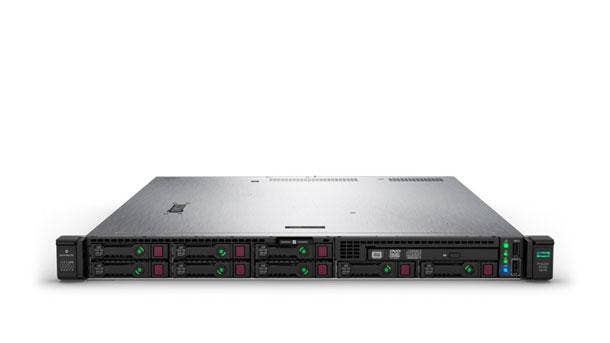
GENERAL-PURPOSE SERVERS
HPE PROLIANT 325 WITH INFOSIGHT
WINNER: OVERALL
In a major update to the tenthgeneration version of Hewlett Packard Enterprise’s ProLiant DL325, the company added improved visibility into server health and status using the HPE InfoSight cloud-based artificial intelligence management platform. InfoSight management capabilities for servers also offer predictive analytics to help reduce maintenance issues. HPE’s expansion of InfoSight to improve management of server environments is a move that makes complete sense, said Dan Molina, CTO of San Diego-based solution provider Nth Generation Computing. InfoSight’s powerful AI-based technology helps pinpoint problems with applications and storage by looking at the application, virtualization and storage layers, Molina said.
Subcategory Winner—Customer Demand: Cisco UCS C480ML M5
Cisco’s UCS C480ML M5 server targets the burgeoning market for artifical intelligence and machine learning with the inclusion of eight Nvidia Tesla V100 data center GPUs, up to 24 hard disk drives and SSDs, up to six PCIe NVME drives and integrated dual 10-Gbps Ethernet.
Finalist: Dell EMC PowerEdge R7515
Dell EMC’s PowerEdge R7515 is a single-socket 2U server that delivers the same level of performance as dual-socket servers while providing a better total cost of ownership—due in part to using AMD’s second-generation EPYC Rome processors, which feature a high core count. Targeted workloads include software-defined storage and virtualization.
Finalist: Lenovo ThinkSystem SR950
Lenovo recently refreshed its flagship ThinkSystem SR950, making it the first eight-socket server to include Intel’s Optane DC persistent memory. The technology enables up to 12.5 times faster recovery after an outage. The 4U server can also include up to eight secondgeneration Intel Xeon Scalable CPUs for double-digit performance improvement.
Finalist: Supermicro SuperServer 2029BR-HER
Supermicro’s SuperServer 2029BR-HER is a 2U, four-node server with room for 10 E1.S EDSFF NVMe drives plus two SATA M.2 SSDs per node. Each hot-pluggable node also supports one or two second-generation Intel Xeon Scalable processors, 24 DIMMs with up to 6 TB of memory and two PCIe 3.0 slots.
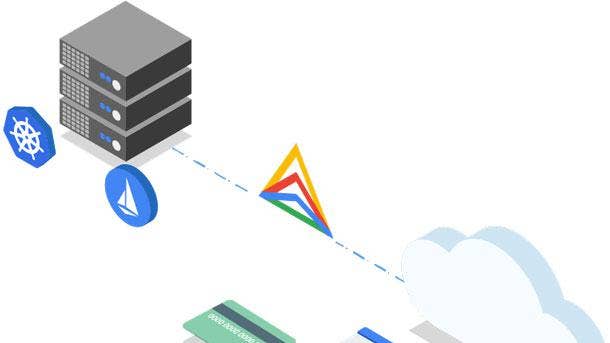
HYBRID CLOUD
GOOGLE CLOUD ANTHOS
WINNER: OVERALL
Google’s hybrid cloud platform Anthos extends the company’s application delivery and management capabilities not only into the corporate data center, but across rival public clouds. Anthos is a rebrand of the Google Cloud Services platform, but with a new emphasis on deploying workloads seamlessly across clouds, stepping into the territory of competitors like AWS. With Anthos, Google’s Kubernetes service now extends to other cloud providers, and the service mesh has seen upgrades for security and deeper visibility into telemetry functions between microservices running on different clouds. Anthos, fully managed by Google, runs on-premises and also supports multi-cloud environments.
Finalist: Dell Technologies Cloud Platforms
The Dell Technologies Cloud Platforms leverages Dell EMC and VMware infrastructure to enable a consistent operating model for hybrid cloud deployments. The offering reduces the complexity of managing multiple clouds, providing consistent infrastructure and operations across data center, edge and public cloud environments.
Finalist: HPE GreenLake-Nutanix Hybrid Cloud as a Service
Hewlett Packard Enterprise has teamed with Nutanix to provide an integrated Hybrid Cloud as a Service, leveraging Nutanix’s Enterprise Cloud OS software and delivered through the breakthrough HPE GreenLake pay-per-use platform. The result is a fully HPE-managed hybrid cloud that offers a significantly reduced total cost of ownership.
Finalist: Lenovo TruScale Infrastructure Services
With TruScale Infrastructure Services, Lenovo delivers a consumption-based data center offering that enables customers to use data center hardware and services without having to purchase the equipment, producing cloud-like economics with the security of on-premises hardware.
Finalist: VMware Cloud Foundation
VMware Cloud Foundation provides integrated cloud infrastructure— compute, storage, networking and security—along with cloud management services to enable hybrid cloud deployments. The offering works with major public cloud platforms AWS, Microsoft Azure, Google Cloud and IBM Cloud—and will soon run on Oracle Cloud Infrastructure as well.
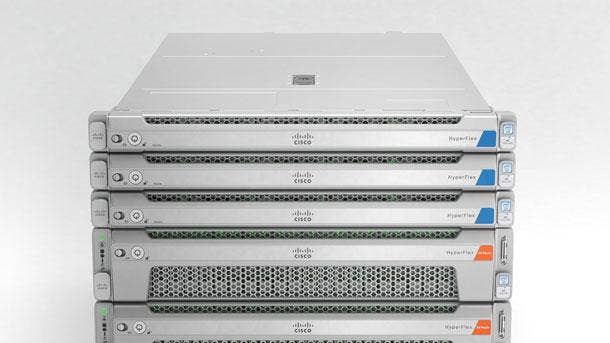
HYPER-CONVERGED INFRASTRUCTURE
CISCO HYPERFLEX
WINNER: OVERALL
HyperFlex combines Cisco’s HX Data Platform and its UCS server portfolio with integrated fabric networking. HyperFlex is a fully integrated appliance that supports VMware vSphere and Microsoft Hyper-V hypervisors, while users can scale compute and storage independently of one another. This year, Cisco rolled out several updates to HyperFlex including AppDynamics for monitoring across multiple clouds. The offering can be bundled with CloudCenter, Cisco’s hybrid cloud management platform. Meanwhile, the Cisco HyperFlex Anywhere strategy extends the simplicity of hyper-convergence from core to edge and multi-cloud through integration with Cisco’s Intersight Software-as-a-Service management platform.
Subcategory Winner—Technology: Nutanix Enterprise Cloud Platform
The Nutanix Enterprise Cloud Platform uses native AHV virtualization with Nutanix’s software-defined storage, compute, data security, software-defined networking and management software. Nutanix’s AHV hypervisor enables reduced cost and an easy migration path, while the company offers robust management with its Prism offering.
Subcategory Winner—Revenue and Profit: HPE SimpliVity
Hewlett Packard Enterprise’s flagship hyper-converged infrastructure offering, SimpliVity, provides robust storage efficiency and data reduction services with always-on global deduplication and compression. Major enhancements for HPE SimpliVity have included the integration of HPE InfoSight, an artificial intelligence management platform that provides the ability to predict and prevent infrastructure issues.
Finalist: Dell Technologies VxRail
VxRail is a tightly integrated platform co-engineered with VMware that includes Dell Technologies’ market-leading servers, storage and software management solutions. VMware Manager comes preinstalled with a dashboard for automating VxRail deployment and configuration, while Dell has lowered the entry point for HCI to let midsize clients start with a two-node VxRail cluster.
Finalist: Scale Computing HC3
Scale Computing’s flagship Hyperconverged Compute Cluster, HC3, leverages its own KVM-based hypervisor together with its management, compute, storage pooling and network virtualization capabilities. Scale Computing’s hybrid cloud integration connects on-premises and cloud infrastructure and data via its HC3 Cloud Unity offering.
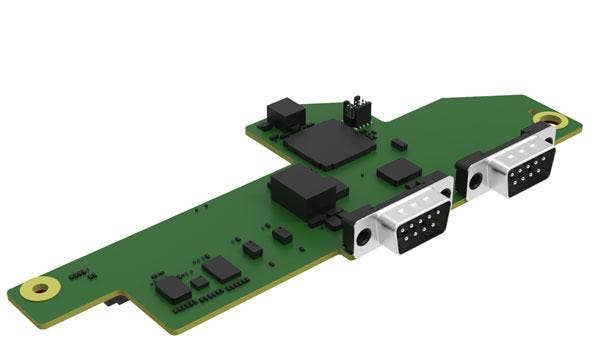
IoT AND EDGE
HPE EDGELINE OT LINK
WINNER: OVERALL
Hewlett Packard Enterprise is pushing boldly into new Internet of Things and edge computing territory with the launch of HPE Edgeline OT Link, an open software platform designed to bridge the gap between operational technology (OT) and IT. HPE Edgeline OT Link provides an open workflow engine and application catalog designed to speed up application delivery with a drag-and-drop capability for OT and IT applications, components and data. The platform automates the interplay between IT and OT applications at the edge to propel a new wave of IoT applications that break ground in industries such as manufacturing, energy and telecommunications.
Subcategory Winner—Customer Demand: Cisco Catalyst IE3x00
With its Catalyst IE3x00 series of switches, Cisco is extending its intent-based networking architecture—which offers benefits including improved scalability and management—to the IoT edge. The switches run on Cisco’s IOS XE operating system, allowing them to be easily upgraded with new technologies, such as 5G.
Finalist: APC by Schneider Electric: HyperFlex for the Edge
Aimed at rapid deployment in edge environments, HyperFlex for the Edge pairs physical infrastructure from APC by Schneider Electric with Cisco’s HyperFlex hyper-converged infrastructure offering. Along with being preintegrated at the factory, key advantages include remote monitoring and management capabilities.
Finalist: Lenovo ThinkSystem SE350
Lenovo’s ThinkSystem SE350 is a compact-size server that’s designed to be used on the edge and features a range of connectivity and durability features. Those include handling temperatures from 32 degrees to 131 degrees Fahrenheit, and tolerating locations with high dust and vibration.
Finalist: Nvidia EGX Platform
Nvidia’s EGX Platform enables powerful artificial intelligence capabilities at the edge with minimal latency. The platform leverages Nvidia technologies including the Jetson Nano module (for performing image recognition and other tasks) and T4 servers (for AI tasks such as speech recognition).
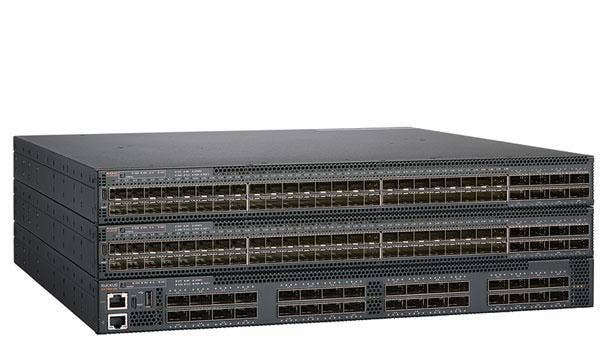
NETWORKING
RUCKUS ICX 7850
WINNER: OVERALL
With the ICX 7850 switch line, Ruckus Networks, now part of CommScope, is bringing more Gigabit throughput from the core to the edge of the network. The Ruckus ICX 7850 switches provide highdensity aggregation with up to 100 Gigabit Ethernet as businesses continue their multi-Gigabit network growth. The ICX 7850 offers advanced stacking—with the option to scale up to 12 switches—as well as an available SmartZone network controller that provides configuration, monitoring and troubleshooting capabilities. The high-performance ICX 7850 line can also use existing fiber and network infrastructure that a business might have in place, for a simple upgrade to the enterprise edge network.
Subcategory Winner—Customer Demand: HPE Aruba 8400
Along with offering massive performance, the HPE Aruba 8400 core switch stands out by running the AOS-CX operating system— a programmable, cloud-native OS with numerous benefits for customers. Those include the ability to automate many network functions, while also gaining actionable insight from the network and proactively remediating network issues.
Finalist: Cisco Catalyst 9600
Following the retirement of the hugely popular Catalyst 6000 series switches, Cisco debuted the Catalyst 9600 core switch family as a successor that is primed for Cisco’s intent-based networking push. The Catalyst 9600 switches enable up to 100 Gigabit Ethernet and feature full-stack programmability to provide future updates without new hardware.
Finalist: Extreme Networks: ExtremeMobility 500 Series
Aimed at providing strong connectivity in dense environments, Extreme Networks this year launched its ExtremeMobility 500 series of 802.11ax access points. Key capabilities of the ExtremeMobility 500 access points include four times greater capacity to enable improved scaling of customer networks.
Finalist: Juniper MX2020 5G
With the MX2020 5G Universal Routing Platform, Juniper Networks provides massive performance and density across edge, core and converged applications. The router offers 80 TBps of system capacity while enabling 100 Gigabit, 200 Gigabit and 400 Gigabit Ethernet capabilities.
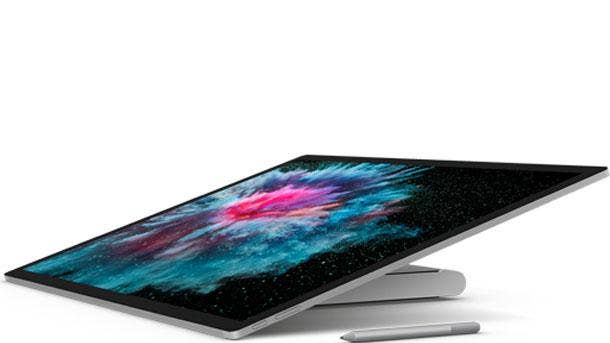
PC-DESKTOPS
MICROSOFT SURFACE STUDIO 2
WINNER: OVERALL
Microsoft brought several key enhancements to the second-generation model of its Surface Studio, an all-in-one targeted at creative professionals such as artists and designers. The Surface Studio 2 moves up to next-generation Nvidia Pascal graphics, a brighter display at 500 nits and up to 2 TB worth of solid-state storage. The second-generation model keeps the 28-inch touch screen and adjustable display positioning of the original model. Adjusting the display all the way downward allows users to work in a drawing board mode, and the display is specially designed to allow leaning into it while working without doing any damage.
Subcategory Winner—Technology: Apple iMac 2019
With this year’s performance-focused update, Apple’s 27-inch iMac now offers ninth-generation Intel processors, featuring six or eight cores. The 21.5-inch iMac now comes with eighth-generation Intel processors, offering four or six cores. Both models are offered with AMD Radeon Pro or Radeon Pro Vega graphics.
Subcategory Winner—Revenue and Profit: HP EliteOne 800 G5 AIO
The EliteOne 800 is HP’s first all-in-one PC with its Sure View integrated privacy screen, which reduces almost all visible light when viewed at an angle. The all-in-one features slim bezels around the display and a pop-up webcam for added privacy.
Finalist: Dell OptiPlex 7070 Ultra
Dell Technologies has unveiled a new breed of all-in-one with the launch of the OptiPlex 7070 Ultra. The PC comes in a form factor that is small enough to fit entirely inside the back of a monitor, offering a “zero-footprint” desktop PC design.
Finalist: Lenovo ThinkCentre M90n Nano
Lenovo's ThinkCentre M90n Nano offers powerful Intel Whiskey Lake processors and up to 16 GB of RAM in a minuscule form factor. The 0.35-liter Nano measures 7 x 3.5 inches, making it not much larger than some smartphones.
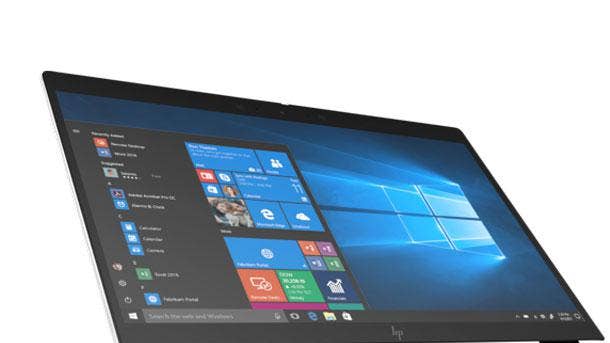
PC-LAPTOPS
HP ELITEBOOK X360 1040 G6
WINNER: OVERALL
HP Inc.’s EliteBook x360 series is one of our favorite business notebook lineups at the CRN Test Center, but the PC maker continues to find areas for improvement with the EliteBook x360 1040 G6. The convertible notebook offers expanded battery life at up to 24 hours on a charge, along with fast-charging capabilities. The EliteBook x360 1040 G6 comes with a 14-inch display featuring optional 4K resolution and an optional outdoor viewable screen with up to 1,000 nits of brightness. The convertible is also highly portable with a weight of less than 3 pounds, and enables strong performance with up to 32 GB of RAM.
Subcategory Winner—Technology: Lenovo ThinkPad X1 Carbon, Seventh Generation
Lenovo enhanced the ThinkPad X1 Carbon for its seventhgeneration update with a new integrated privacy screen and optional 4K/UHD resolution, with brightness of up to 500 nits. For the body, the 4K X1 Carbon model features a new woven carbon-fiber finish.
Subcategory Winner—Customer Demand: Microsoft Surface Laptop 2
For the second-generation model of the Surface Laptop— Microsoft’s clamshell notebook aimed at student users—the notebook gets a boost on performance with the inclusion of eighth-generation Intel Core processors. The Surface Laptop 2 also adds a new black model to the list of color options.
Finalist: Apple MacBook Pro 2019
Apple’s 2019 MacBook Pro update added speedier eighth-generation and ninth-generation Intel Core processor options for both the 13inch and 15-inch models with Touch Bar. Apple also changed the materials used in its MacBook Pro keyboard mechanism in an attempt to reduce user issues with sticky and unresponsive keys.
Finalist: Dell Latitude 7400 2-in-1
Dell’s Latitude 7400 2-in-1 swaps out the usual black carbon-fiber body for brushed aluminum, while a slim-bezel design around the display reduces the overall size of the notebook. Battery life can reach up to 24 hours on a charge, and the notebook offers an option for speedy LTE connectivity.
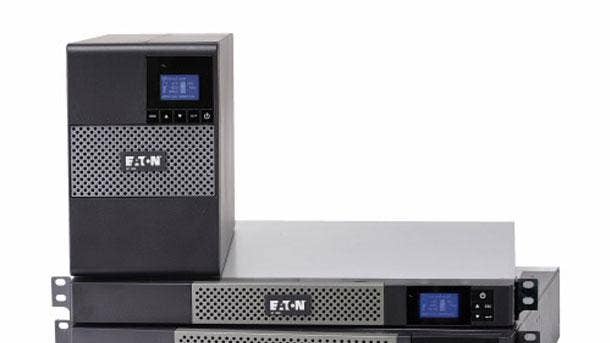
POWER MANAGEMENT SOFTWARE AND TOOLS
EATON 5P LITHIUM-ION UPS
WINNER: OVERALL
Offering benefits including enhanced battery performance, management and security, Eaton’s 5P Lithium-Ion UPS is primed for deployment in environments such as distributed IT and edge. The addition of new lithium-ion battery technology brings performance improvements over lead-acid batteries, while the inclusion of an on-board battery management system provides insight into the battery’s state of health. Key battery insight surfaced by the system includes charge cycles, performance and temperature monitoring. Meanwhile, an optional Gigabit network card, which is compliant with UL 2900-2-2 standards, also provides enhanced cyberprotection with Eaton’s 5P Lithium-Ion UPS.
Subcategory Winner—Revenue and Profit: CyberPower Smart App Online High-Density UPS Systems
CyberPower’s Smart App Online High-Density UPS Systems provide assurance of maximum capacity output with a lower space footprint. In contrast to competing UPS models that require 3U or 4U rack space allotments, CyberPower’s offering is capable of configuration as either a 2U rack unit or a tower unit.
Subcategory Winner—Customer Demand: Tripp Lite SmartPro UPS Systems
With its SmartPro UPS Systems, Tripp Lite offers lithium-ion battery technology that is 60 percent lower weight and offers improved longevity compared with lead-acid batteries. The batteries can also fully recharge in 1.5 hours, compared with typical 24-hour recharges for comparable lead-acid systems.
Finalist: Schneider Electric EcoStruxure Power 2.0
Schneider Electric’s EcoStruxure Power 2.0 offers enhanced management of power distribution and energy, with capabilities including a second-generation Wiser Energy System for improved monitoring of energy usage. The Easergy P3 system and arc flash protection relay, meanwhile, serve to limit equipment damage and save operational time.
Finalist: Vertiv Liebert GXT5
With the Liebert GXT5 series, Vertiv offers a power factor of up to 1.0 on certain models, along with efficiency gains in online and Active ECO modes. Liebert GXT5 models are Energy Star 2.0 certified, and offer remote management along with individually controlled sockets for enhanced security.
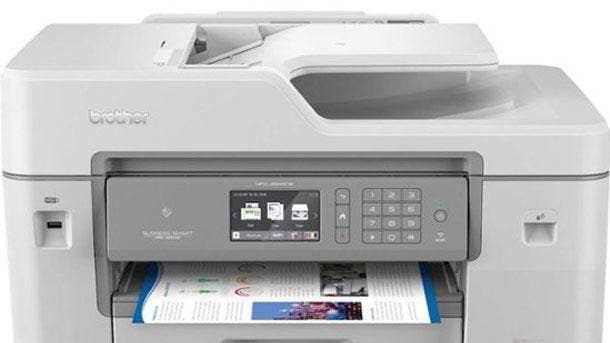
PRINTERS/MFPs
BROTHER MFC-J5945DW
WINNER: OVERALL
Aimed at small businesses, Brother International’s MFC-J5945DW specializes in offering simplified management of printing supplies. Part of Brother’s INKvestment Tank all-in-one lineup, the MFC-J5945DW includes up to an entire year’s worth of ink in the box with the printer. The ink cartridges are also easy to insert and offer high page volumes. In addition, the MFC-J5945DW includes Brother’s recently introduced Page Gauge feature, which provides an estimate on how many printed pages are remaining with the cartridge. The device includes paper capacity of up to 500 sheets, along with print speeds of 22 pages per minute in black and white, and 20 pages per minute in color.
Subcategory Winner—Technology: HP LaserJet 600 Series
HP Inc.’s updated A4 portfolio this year includes the new LaserJet 600 Series. Improvements include cartridge access control, which ensures that all toner is used before the cartridge can be replaced; fixed tray guides, which help to reduce paper jams; and predictive sensors, which can reduce service costs by up to 17 percent.
Finalist: Epson WorkForce Enterprise WF-M20590
A high-performance A3 multifunction device, Epson America’s WorkForce Enterprise WF-M20590 delivers monochrome print speeds of 100 pages per minute and a maximum paper capacity of 5,350 pages. The WF-M20590 also uses up to 50 percent less power than monochrome laser printers.
Finalist: Lexmark MC3224adwe
Aimed at small businesses, Lexmark’s MC3224adwe multifunction device offers print speeds of up to 24 pages per minute in color; scanning, copying and faxing capabilities; wireless printing and scanning; and connectivity over Ethernet and USB as well.
Finalist: Xerox B215
With the B215 multifunction printer, Xerox provides high-speed Wi-Fi Direct connectivity, enabling wireless printing (without the need for a router) and mobile printing using Apple AirPrint, Google Cloud Print, Mopria and Android. Print speeds for the B215 reach up to 30 pages per minute in black and white.
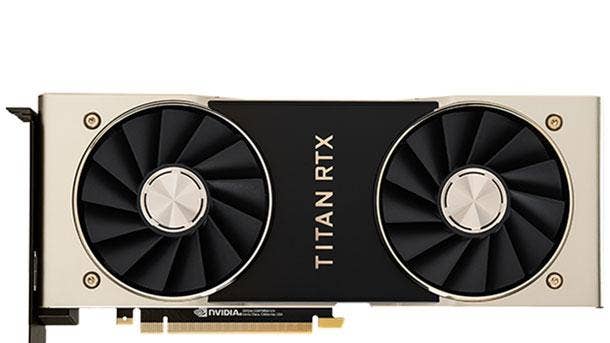
PROCESSORS
NVIDIA TITAN RTX
WINNER: OVERALL
Nvidia’s flagship Titan RTX desktop GPU delivers massive performance for demanding applications such as artificial intelligence research, data science and content creation. The GPU builds off Nvidia’s AI-boosted Turing graphics processor architecture. The Titan RTX includes 576 multi-precision Turing Tensor Cores for deep-learning performance, and 24 Gigabytes of high-speed GDDR6 memory—double the memory of last-generation Titan GPUs. The Titan RTX ultimately delivers 130 teraflops of deeplearning performance. Meanwhile, the Titan RTX includes 72 Turing RT cores for ray-tracing performance, the next-generation rendering technique that realistically models how light interacts with objects to produce cinema-quality graphics in real time.
Subcategory Winner—Technology: Intel Xeon Scalable, 2nd Gen
Via Intel’s Deep Learning Boost technology, the second-generation Xeon Scalable processors are the first to feature built-in inference acceleration for artificial intelligence workloads. The highestperformance processor in the series is the Xeon Scalable Platinum 9200, which offers up to 56 cores and a design that gives each CPU core access to expanded memory interfaces.
Subcategory Winner—Revenue and Profit: AMD EPYC, Second Generation
AMD’s second-generation EPYC processors are the industry’s first 7-nanometer server CPUs, designed to enable high-performance workloads such as artificial intelligence and machine learning. They feature up to 64 cores with base frequencies of up to 3.2GHz.
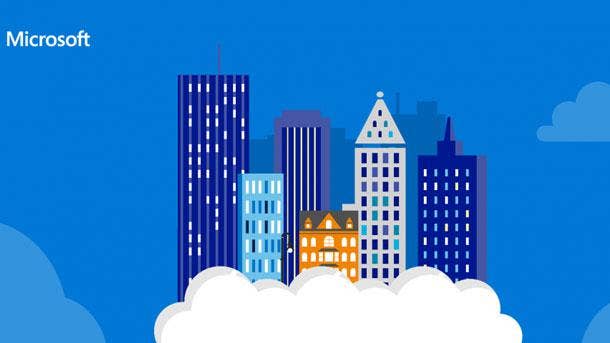
PUBLIC CLOUD
MICROSOFT AZURE
WINNER: OVERALL
Microsoft Azure has transformed into a more manageable service for both larger and smaller partners that represents one of the fastest growth opportunities in the channel, solution providers have told CRN. Azure is now “a great fit for the SMB market,” said Travis Adair, principal partner and vice president at Columbia, Mo.-based InfiniTech Consulting. “Microsoft has made it a lot easier for us to understand and to make money off the product,” he said. In CRN’s 2019 Products of the Year survey, solution providers ranked Azure as No. 1 in all three subcategories—Technology, Revenue and Profit, and Customer Demand.
Finalist: Amazon Web Services
In CRN’s 2019 Products of the Year survey of solution providers, Amazon Web Services ranked at No. 2 overall among the five public cloud providers included in the survey. AWS ranked at No. 2 in the Customer Demand subcategory while ranking at No. 4 in Technology and at No. 5 in Revenue and Profit.
Finalist: Google Cloud
Solution providers ranked Google Cloud at No. 3 overall among public cloud providers in CRN’s 2019 Products of the Year survey. Google Cloud ranked at No. 3 in the Customer Demand subcategory, at No. 4 in Revenue and Profit, and at No. 5 in Technology.
Finalist: IBM Cloud
IBM Cloud was ranked by solution providers at No. 4 overall in public cloud in CRN’s 2019 Products of the Year survey. IBM Cloud ranked at No. 2 in the Technology subcategory, while ranking at No. 3 in Revenue and Profit. However, solution providers ranked IBM at No. 5 in Customer Demand for public cloud.
Finalist: Oracle Cloud
In CRN’s 2019 Products of the Year survey, solution providers gave Oracle Cloud the No. 5 ranking among public cloud providers. Oracle Cloud ranked at No. 2 in the Revenue and Profit subcategory, at No. 3 in Technology and at No. 4 in Customer Demand.
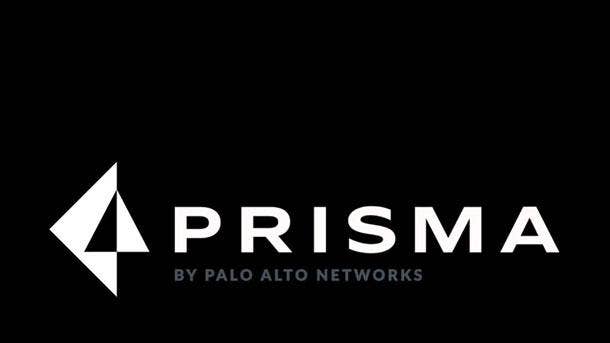
SECURITY-CLOUD
PALO ALTO NETWORKS PRISMA
WINNER: OVERALL
Palo Alto Networks launched the Prisma security suite to simplify access, data protection and application security in the cloud. Among the main components are Prisma Access, which offers cloud-native architecture in securing cloud access for branch offices and mobile users; Prisma Cloud, a machine-learningpowered solution that offers continuous visibility and compliance monitoring for multi-cloud deployments; the Prisma SaaS cloud access security broker service for securing the adoption of Softwareas-a-Service applications; and VM-Series, a virtualized version of the company’s Next-Generation Firewall for deployment in public and private cloud computing environments.
Subcategory Winner—Revenue and Profit: WatchGuard Cloud
WatchGuard Cloud simplifies how MSPs protect customers while reducing infrastructure costs and delivering scalability through multitier, multitenant capabilities. The platform centralizes security management and reporting of all WatchGuard security services into a single cloud-based interface.
Finalist: Check Point CloudGuard
With CloudGuard, Check Point Software Technologies offers protection against sophisticated threats targeting Software-as-a-Service applications and cloud-based email. Key capabilities include offerings to secure against malware and zero-day threats, phishing attacks, employee account takeovers and unsanctioned SaaS application usage.
Finalist: McAfee MVision Cloud
McAfee’s MVision Cloud offers a forward proxy, reverse proxy and rich native integrations with APIs inside larger cloud providers—as well as CASB Connect, which can be wrapped around applications moving to the public cloud so that security teams can deliver data protection in a more streamlined fashion.
Finalist: SonicWall Cloud App Security
SonicWall Cloud App Security 2.0 provides real-time protection for business-critical SaaS applications to thwart never-before-seen malware variants, targeted phishing attacks and account takeover due to compromised credentials and data loss. It supports Microsoft Office 365, G Suite, Box and Dropbox.
Finalist: Symantec CloudSOC CASB
Symantec’s CloudSOC CASB provides visibility, security and threat protection for any cloud application, including mobile and browserbased versions. CloudSOC also has an API offering that reduces the time it takes to identify and remediate security incidents. Provisioning CASB on mobile devices is simplified through integration with Symantec Endpoint Protection Mobile.
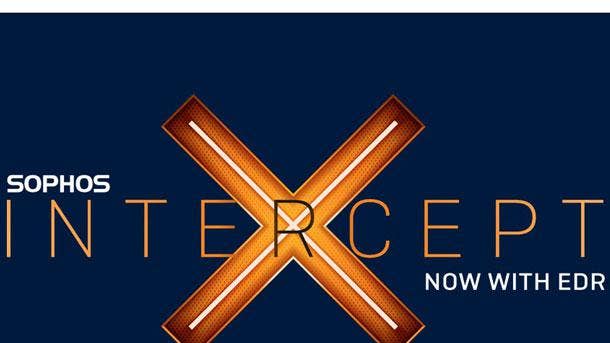
SECURITY-ENDPOINT
SOPHOS INTERCEPT X
WINNER: OVERALL
Sophos has introduced endpoint detection and response (EDR) to its Intercept X endpoint protection offering to make threat tracking accessible to businesses with more limited resources. The offering provides organizations of all sizes with the capabilities one would find in a Security Operations Center. By applying deep learning expertise to the EDR space, Sophos is able to arm companies with threat intelligence and prioritize alerts that appear to be the most threatening or problematic for the business. The EDR tool is able to search across the organization to provide a view of everything that happened in an attack, including executable files and Word documents.
Subcategory Winner—Revenue and Profit: SonicWall Capture Client
SonicWall Capture Client 2.0 increases administrators’ response time, visibility and insight into advanced threats, with advanced endpoint detection and response capabilities. Administrators can now track threat origins and intended destinations, kill and quarantine as necessary, and roll back endpoints to their last-known healthy state in the event of an infection.
Finalist: CrowdStrike Falcon
Recent updates to CrowdStrike Falcon added tailored intelligence, enabling real-time identification of emerging DDoS and botnet threats; instant visibility into external threats; and capabilities to easily create custom behavioral threat detection. Meanwhile, users can now remotely connect to macOS hosts and run predefined commands to immediately respond to threats.
Finalist: McAfee MVision Endpoint
Recent enhancements to McAfee MVision Endpoint include capabilities to configure the offering to route communication through proxy servers; copy and remove firewall rules; prevent users from editing Windows Defender exclusions; and provide improved detection of malware based on Microsoft Word and Excel documents.
Finalist: Symantec Endpoint Protection
Endpoint Protection from Symantec, a Division of Broadcom, includes Endpoint Application Control (whitelisting that only lets known applications run); Endpoint Application Isolation (for safe download and use of applications through ensuring applications are restricted to authorized behavior); and Endpoint Cloud Connect Defense (which protects against risky networks with a policy-based VPN).
Finalist: Webroot Business Endpoint Protection
Webroot’s Business Endpoint Protection includes notable features such as rapid deployment, fully remote endpoint management and fully automated operation, which enables organizations to use preconfigured policy templates. The offering also provides whitelisting and blacklisting, intelligent firewall, full offline protection and comprehensive protection against zero-day threats.
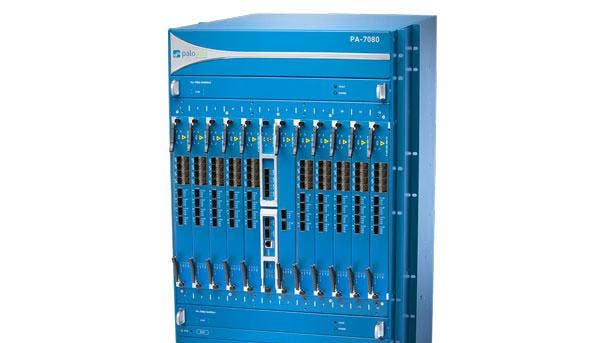
SECURITY-NETWORK
PALO ALTO NETWORKS NEXTGENERATION FIREWALL
WINNER: OVERALL
With updates to Next-Generation Firewall, Palo Alto Networks is offering enhanced predictive and automation capabilities in network security. In terms of predictive and preventative capabilities, a new DNS Security service blocks malicious domains and halts attacks that are under way by leveraging machine-learning technologies. The updated offerings include the Palo Alto Networks PA-7000 Series next-generation firewall, featuring improved network processing cards with accelerated threat prevention and decryption.
In addition, an upgraded Policy Optimizer enables security teams to introduce easier-to-manage policies, while the latest version of NextGeneration Firewall also supports better automation of security for large-scale deployments in public cloud.
Subcategory Winner—Technology: Fortinet Secure SD-WAN
Key innovations in Fortinet’s Secure SD-WAN include the industry’s first SD-WAN ASIC chip, which helps to ensure both performance and security. The chip can run and define applications rapidly while at the same time applying leading security practices.
Finalist: Check Point Maestro
In a move to help companies more easily scale up their security gateways, Check Point Software Technologies launched Check Point Maestro. Its architecture provides seamless expansion of security gateways to hyperscale-level capacities—with a single gateway now capable of expanding to the capacity of 52 gateways within minutes.
Finalist: Cisco Stealthwatch
Cisco’s expanded Stealthwatch platform features threat detection capabilities in both unencrypted and encrypted traffic, spanning from multi-cloud environments to private networks. Stealthwatch monitors all device activity and ultimately delivers a single view of threats across an organization’s full environment.
Finalist: HPE Aruba ClearPass Device Insight
Using machine learning, HPE Aruba's ClearPass Device Insight provides automatic discovery of all connected devices across any wired or Wi-Fi network. This enables businesses to determine what parts of the network or servers a device should be able to access.
Finalist: Sophos XG Firewall
In a move to enable comprehensive network protection, Sophos updated its XG Firewall with lateral movement protection capabilities. The capabilities prevent targeted manual cyberattacks from getting into compromised networks, using automated isolation of compromised systems across each point in the network.
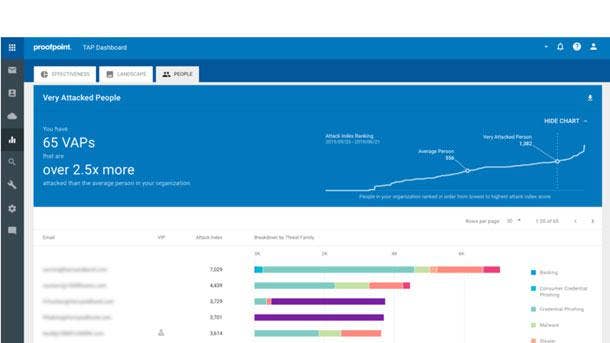
SECURITY-WEB AND EMAIL
PROOFPOINT EMAIL PROTECTION
WINNER: OVERALL
Proofpoint’s Email Protection offering brings together malware detection and blocking with protection against phishing and email fraud threats, enabling fast response to security incidents and prevention of information loss. Key benefits include visibility into the most vulnerable employees that might be targeted within an organization—with that visibility provided by an integrated threat dashboard. Proofpoint Email Protection offers multilayered content analysis to put a stop to threats both known and previously unknown, with capabilities such as signature-based detection prevents paired with dynamic reputation analysis for determining how to manage potential email connections.
Finalist: Barracuda Total Email Protection
With Total Email Protection, Barracuda Networks combines its Barracuda Essentials email security offering with spear phishing defense capabilities and security awareness training. Total Email Protection also allows MSPs to customize implementations to address unique customer requirements in a more simplified fashion.
Finalist: FireEye Email Security
FireEye Email Security now provides full secure email gateway functionality—blocking inbound and outbound malware, phishing URLs and impersonation techniques. Along with standard secure email gateway capabilities such as anti-virus, anti-spam and signature-based anti-malware, FireEye Email Security is designed to better protect customers with threat intelligence gathered from the frontlines.
Finalist: Mimecast Email Security with Targeted Threat Protection
Using Mimecast’s Email Security with Targeted Threat Protection, organizations can leverage multiple detection engines—along with a variety of threat intelligence offerings—to enable email protection from malware, spam, phishing and targeted attacks. Email Security with Targeted Threat Protection is delivered entirely as a cloudbased service.
Finalist: Netskope NextGen SWG
With its NextGen SWG (Secure Web Gateway), Netskope provides advanced capabilities around cloud-based web security—including detection of threats and other malicious activity (via pre-execution script analysis); dynamic sandboxing; and anomaly detection that leverages machine learning to protect both users and data across web activity.
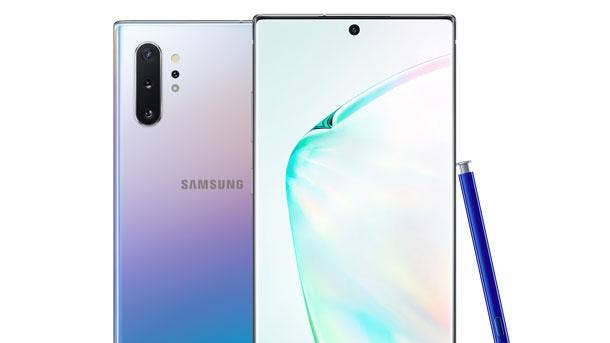
SMARTPHONES
SAMSUNG GALAXY NOTE 10 PLUS
WINNER: OVERALL
Samsung isn’t running out of compelling new ideas for its long-running Galaxy Note series. For the first time in the Note series, Samsung has launched two sizes for the Note—with the Note 10 Plus coming as the larger model at a massive 6.8 inches. The Note 10 Plus offers expanded display brightness of up to 800 nits outdoors, and business-friendly features include easier connectivity from the phone to the DeX Android desktop. The Note 10 Plus is also impressively thin for having such a large screen (at 0.31 of an inch thick) and lightweight, too, at 0.43 of a pound.
Subcategory Winner—Technology: Apple iPhone 11
Apple’s iPhone 11 features the same 6.1-inch LCD display as its predecessor iPhone XR, but with a price cut, dual camera and improved performance. Compared with the single rear camera on the iPhone XR, the iPhone 11 moves up to dual rear 12-megapixel cameras—while also adding Apple’s latest processor, the A13 Bionic.
Subcategory Winner—Revenue and Profit: Google Pixel 3 XL
Google’s Pixel 3 XL aims to stand out from the pack with advanced camera features such as “Top Shot,” which captures numerous photos and recommends the best ones. Another key camera feature, “Super Res Zoom,” shoots a burst of photos and merges elements of the photos to present the best possible shot.
Finalist: Motorola Moto Z3 5G
Motorola Moto Z3 5G features a 5G modular add-on that snaps onto the back of the Moto Z3. The phone includes Qualcomm’s Snapdragon X50 5G modem along with dedicated antennas for accessing Verizon’s ultra-wideband network. It also includes a 2,000 mAh battery to prevent battery drain from faster data speeds.
Finalist: OnePlus 7 Pro
The OnePlus 7 Pro features a large, 6.67-inch “Fluid AMOLED” display with a 90Hz refresh rate, which aims to provide a smoother display appearance. The smartphone also offers slim bezels around the QHD+ display, and the screen curves around the edges of the phone as well.
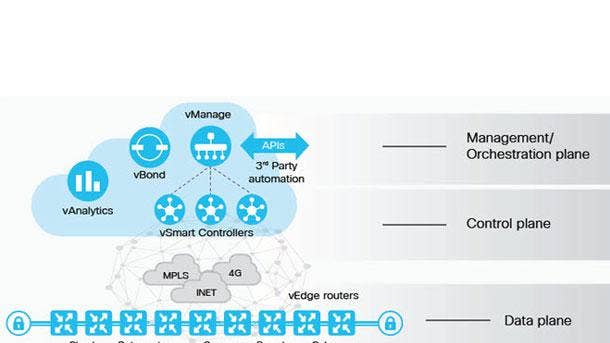
SOFTWARE-DEFINED NETWORKING
CISCO SD-WAN
WINNER: OVERALL
Cisco offers two flavors of SDWAN: Cisco Meraki and Cisco SD-WAN powered by Viptela, an offering derived from the acquisition of SD-WAN startup Viptela. The cloud-based Cisco Meraki SD-WAN with unified threat management capabilities offering is included with an enterprise license on Meraki MX SD-WAN and security appliances and requires no extra servers or hardware. Cisco SD-WAN powered by Viptela is a cloud-based offering that separates data and control planes. Users can manage the offering via the Cisco vManage console and establish an SD-WAN overlay to connect data centers, branches, campuses and colocation facilities to improve network speed, security and efficiency.
Finalist: CloudGenix CloudBlades
With CloudBlades, CloudGenix reimagines remote office IT infrastructure into an entirely cloud-based environment. The CloudBlades platform can give branch offices all the IT services they need—such as cloud-based SD-WAN, security and voice services, as well as multi-cloud access and operational tools—in one place without any additional hardware or software.
Finalist: HPE Aruba Software-Defined Branch
HPE Aruba’s Software-Defined Branch and SD-WAN, managed on the Aruba Central network management platform, have seen enhancements to enable easier deployment of edge infrastructure at a large scale. Aruba Central now includes branch management capabilities with a new SD-WAN Orchestrator.
Finalist: Silver Peak Unity EdgeConnect
The Silver Peak Unity EdgeConnect SD-WAN edge platform allows users to connect securely and directly from branch offices to cloud applications via broadband connections, while still providing applications with strong performance. Silver Peak’s SD-WAN services include application visibility and a zone-based firewall via partnerships with security providers such as Palo Alto Networks.
Finalist: VMware NSX
Recently introduced VMware NSX offerings include the new SDN SmartFabric Director, which enables the physical switch underlay infrastructure to keep pace with the changing demands of virtualized and software-defined networks. Based on Dell PowerSwitch switches, the offering tightly integrates VMware vSphere and NSX-T to correctly provision application workloads.
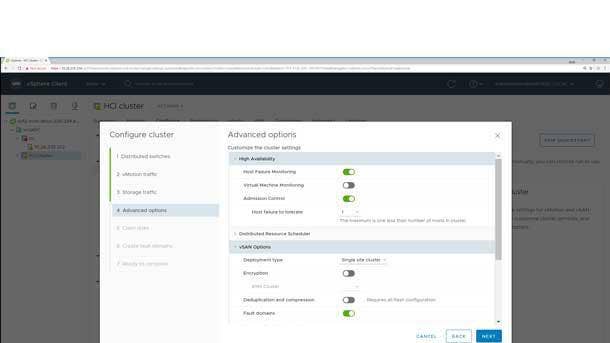
SOFTWARE-DEFINED STORAGE
VMWARE VSAN
WINNER: OVERALL
Enhancements to VMware vSAN 6.7 have included capabilities making it easier for customers to adopt hyper-converged infrastructure via simplified operations, efficient infrastructure and rapid support resolution. Administrators can now quickly spin up new hyper-converged infrastructure clusters faster while reducing maintenance operations time. The new HCI deployment helps deliver improved efficiency due to automated capacity reclamation, and helps administrators anticipate data needs with new predictive tools. The offering also now takes advantage of granular diagnostic tools and historical data to help decrease time-to-resolution when issues arrive. Other updates have brought tight integration with Kubernetes container orchestration through using a Container Storage Interface driver for vSphere.
Finalist: DataCore One
DataCore Software’s DataCore One offering centralizes the control of varying classes of storage across primary, secondary and archive. Key capabilities include DataCore Insight Services—a cloud-based engine for predictive storage analytics to enable early detection of issues, capacity planning and recommendations.
Finalist: Microsoft Storage Spaces Direct
Recent upgrades to Microsoft Storage Spaces Direct in Windows Server 2019 include deduplication and compression for Microsoft’s Resilient File System volumes, enabling storage of up to 10 times more data on the same volume. Storage Spaces Direct also now offers native support for persistent memory such as Intel Optane DC.
Finalist: NetApp Cloud Volumes
Updates have included the addition of support for NetApp Cloud Volumes on HCI, enabling the extension of Cloud Volumes’ highperformance persistent storage to on-premises deployments. NetApp also unveiled Cloud Volumes OnTap for Google Cloud to bring enhanced performance, availability and data protection capabilities for running applications in Google Cloud.
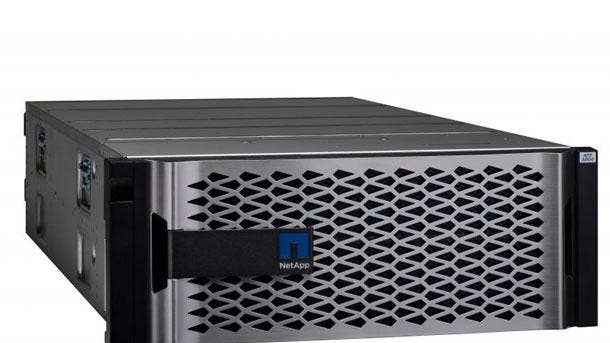
STORAGE-ENTERPRISE
NETAPP AFF A800
WINNER: OVERALL
NetApp’s AFF A800 all-flash storage array is a groundbreaking NVMe end-to-end offering that features latency of under 200 microseconds. The array supports data transfer of up to 300 Gbps and performance of up to 11.4 million IOPS in a 24-node cluster. The AFF A800 comes ready to attach to high-speed 16-Gbps and 32-Gbps Fibre Channel networks, as well as 100-Gbps Ethernet. The AFF A800 has an enhanced version of NetApp’s Active IQ web-based analytics software that provides predictive analytics for technical support based on information from the billions of data points collected from the field each day.
Subcategory Winner—Technology: IBM FlashSystem 9100
IBM launched a new version of its VersaStack converged infrastructure offering built in conjunction with Cisco that features the IBM FlashSystem 9100, IBM’s first NVMe-based storage platform. It features NVMe-over-Fibre Channel connectivity, with NVMe-overEthernet expected late this year or early 2020.
Subcategory Winner—Customer Demand: Dell EMC PowerMax 8000
Dell EMC has introduced enhancements to its flagship PowerMax line including an ability to work with the company’s Cloud Storage Services, for extending data center storage services to public clouds. Dell EMC also launched new storage-class memory technology for a major jump in performance with the PowerMax line.
Finalist: HPE Primera 600
HPE Primera brings together Hewlett Packard Enterprise’s InfoSightbased predictive analytics with the company’s highly reliable 3Par arrays. The all-flash HPE Primera brings InfoSight to on-premises environments, including to non-cloud-connected data centers, and can be installed in less than 20 minutes.
Finalist: Pure Storage FlashArray//X90
All-flash storage technology developer Pure Storage has significantly increased its FlashArray//X performance with its DirectFlash Fabric technology. DirectFlash Fabric replaces iSCSI connectivity with RDMA over converged Ethernet for up to a 50 percent reduction in latency over iSCSI, and a 20 percent performance gain over Fibre Channel.
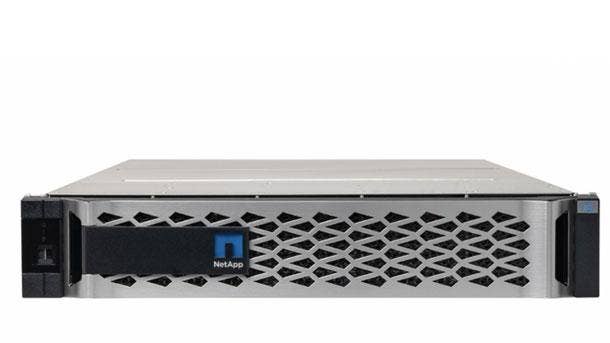
STORAGE-MIDRANGE
NETAPP AFF A320
WINNER: OVERALL
NetApp this year introduced the AFF A320 all-flash storage system, calling it the first midrange storage array to offer end-to-end NVMe performance. The A320 is a 2U array with 100 Gigabit Ethernet ports and support for NVMe SSDs. It is supported by a new expansion shelf also supporting NVMe that is connected via NVMe-over-RoCE, and scales to a maximum of 24 nodes with 576 SSDs for up to 35 petabytes of maximum capacity. It features latency as low as 100 microseconds, as well as the full range of NetApp storage services.
Subcategory Winner—Technology: HPE Nimble Storage
Hewlett Packard Enterprise has expanded its InfoSight AI Recommendation Engine to boost the performance of the Nimble storage platform. InfoSight—which uses machine learning to prevent storage issues—now delivers recommendations on how to optimize the performance of VMware on Nimble storage with specific actions that can be taken to address storage performance bottlenecks.
Subcategory Winner—Revenue and Profit: IBM Storwize V5100
IBM has expanded its Storwize storage system line with new versions of its Storwize 5000 family that bring high-performance NVMe storage to a wider range of customers. At the top of the Storwize V5000 family is the V5100/F, which includes IBM’s NVMepowered FlashCore storage technology, with scalability to up to 1,520 flash drives.
Subcategory Winner—Customer Demand: Dell EMC Unity XT
Dell EMC’s Unity XT all-flash arrays use software enhancements and the latest generation of Intel processors to double the performance of the previous generation. Unity XT is also NVMe-ready, meaning that customers will ultimately be able to receive a nondisruptive software upgrade to take advantage of high-performance NVMe.
Finalist: StorageCraft OneXafe 5410
StorageCraft’s OneXafe 5410 object-based storage offering runs the OneXafe converged data platform—providing scale-out storage with data protection for both physical and virtualized environments. The OneXafe platform offers integrated data management and data protection designed to meet midsize-business needs. n